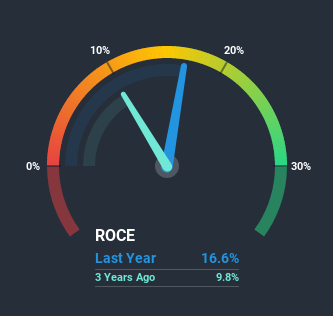What Can The Trends At GLG (ASX:GLE) Tell Us About Their Returns?
If you're not sure where to start when looking for the next multi-bagger, there are a few key trends you should keep an eye out for. Ideally, a business will show two trends; firstly a growing return on capital employed (ROCE) and secondly, an increasing amount of capital employed. Basically this means that a company has profitable initiatives that it can continue to reinvest in, which is a trait of a compounding machine. Speaking of which, we noticed some great changes in GLG's (ASX:GLE) returns on capital, so let's have a look.
Understanding Return On Capital Employed (ROCE)
Just to clarify if you're unsure, ROCE is a metric for evaluating how much pre-tax income (in percentage terms) a company earns on the capital invested in its business. Analysts use this formula to calculate it for GLG:
Return on Capital Employed = Earnings Before Interest and Tax (EBIT) ÷ (Total Assets - Current Liabilities)
0.17 = US$13m ÷ (US$141m - US$65m) (Based on the trailing twelve months to December 2020).
Therefore, GLG has an ROCE of 17%. In absolute terms, that's a satisfactory return, but compared to the Luxury industry average of 8.4% it's much better.
Check out our latest analysis for GLG
While the past is not representative of the future, it can be helpful to know how a company has performed historically, which is why we have this chart above. If you're interested in investigating GLG's past further, check out this free graph of past earnings, revenue and cash flow.
What Does the ROCE Trend For GLG Tell Us?
The trends we've noticed at GLG are quite reassuring. Over the last five years, returns on capital employed have risen substantially to 17%. The amount of capital employed has increased too, by 31%. This can indicate that there's plenty of opportunities to invest capital internally and at ever higher rates, a combination that's common among multi-baggers.
On a side note, GLG's current liabilities are still rather high at 46% of total assets. This effectively means that suppliers (or short-term creditors) are funding a large portion of the business, so just be aware that this can introduce some elements of risk. Ideally we'd like to see this reduce as that would mean fewer obligations bearing risks.
The Key Takeaway
All in all, it's terrific to see that GLG is reaping the rewards from prior investments and is growing its capital base. Since the total return from the stock has been almost flat over the last five years, there might be an opportunity here if the valuation looks good. That being the case, research into the company's current valuation metrics and future prospects seems fitting.
On a final note, we found 5 warning signs for GLG (2 are significant) you should be aware of.
While GLG isn't earning the highest return, check out this free list of companies that are earning high returns on equity with solid balance sheets.
This article by Simply Wall St is general in nature. It does not constitute a recommendation to buy or sell any stock, and does not take account of your objectives, or your financial situation. We aim to bring you long-term focused analysis driven by fundamental data. Note that our analysis may not factor in the latest price-sensitive company announcements or qualitative material. Simply Wall St has no position in any stocks mentioned.
Have feedback on this article? Concerned about the content? Get in touch with us directly. Alternatively, email editorial-team (at) simplywallst.com.

